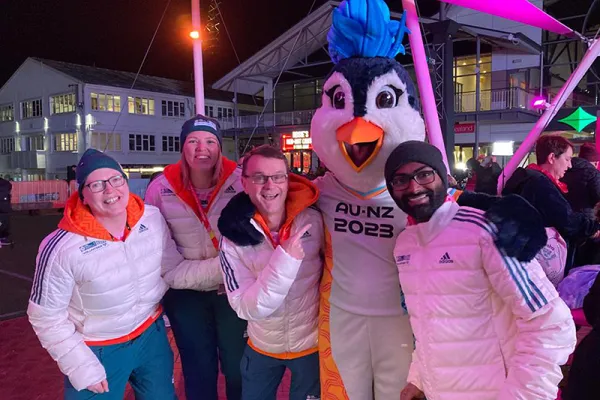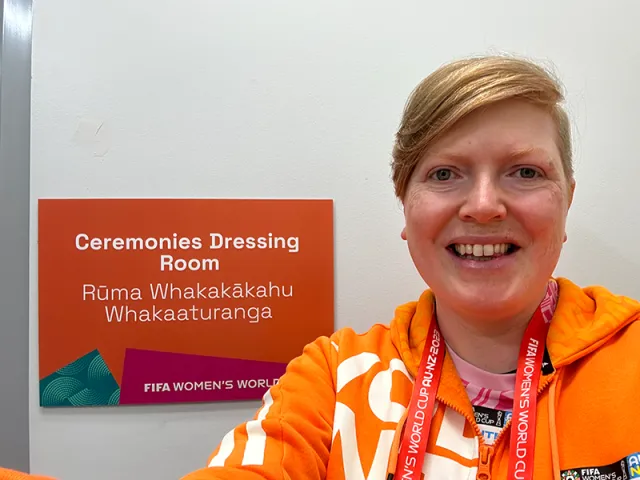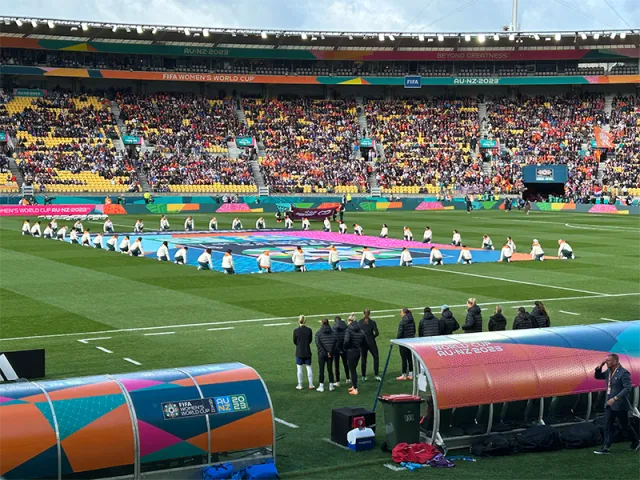Dispatch from the FIFA Women’s World Cup
Athletics
Valerie Love ’02, long inspired by U.S. women’s soccer, jumped at the chance to volunteer at the World Cup.

Published August 7, 2023
I’ve never played soccer. In high school, field hockey was my sport, and then when I went to Smith I took up ice hockey. But I’ve been a massive fan of the United States Women’s National Soccer Team (USWNT) ever since I watched their epic win at the 1999 World Cup. It was the summer after my first year at Smith, and just a few months after I’d come out
There were so many greats on that team: Mia Hamm, Julie Foudy, Christine Lilly, Brianna Scurry. And, of course, who could forget that iconic moment when Brandi Chastain shattered gender norms and celebrated the win the same way men do—by ripping off their shirts and waving them around. It was official: I was a fan.
Two decades later, in 2019, I was living and working in New Zealand. On mornings when the U.S. team was playing, I’d wake up early to meet my American colleagues at the sports bar at Wellington Station, which opened at 7 a.m., and together we’d watch the matches. The eggs on toast weren’t very good, and the coffee was even worse, but the games were incredible. We watched on the edge of our seats as the USWNT won their fourth title. It was all worth arriving late to work.
Needless to say, when it was announced that the 2023 World Cup would actually be coming to my little corner of the world, I was ecstatic. I immediately applied to volunteer, so I could be a part of it in some way. It was the first women’s World Cup to be jointly held by two nations, and the first held in the southern hemisphere during winter. It was also the largest ever women’s sporting event, with 32 teams competing this year, and the third-largest sporting event in the world (after the Olympics and the FIFA Men’s World Cup).
Applying to be a FIFA Women’s World Cup volunteer was not unlike applying for a job. After passing the interview stage and background check, I was offered a host city relations volunteer role. In my case that meant supporting some of the pre-match ceremonies and working at the Wellington Fan Festival along the waterfront at Queens Wharf.
At Wellington Stadium in my volunteer orange.
Although the two volunteer roles I took on were quite different, they had one thing in common: intense physical work. Being part of the pre-match ceremonies meant arriving at the stadium five and a half hours before the game to prepare the flags and banners, and to rehearse our movements and choreography. The host city banner was 20 meters by 30 meters in size. A minimum of 40 volunteers were needed to carry it out onto the pitch.
Volunteering at the fan festival meant supporting visitors to the city. It was a joy to see crowds of people all decked out in gear from their home countries, meeting up first at the fan festival to all walk to the stadium together. The festival had free concerts, including one by my all-time favorite Kiwi musician Ladyhawke, as well as gaming stations, children’s activities, food, and places to sit and relax and watch the matches on a giant screen.
On the pitch at the U.S vs. the Netherlands match, Valerie Love ’02 is at left, sixth from the bottom in the pink section.
The most popular activity at the fan festival was a miniature soccer pitch set up in the square where people could just kick some soccer balls around. It was often full of young people, but I definitely enjoyed seeing women still in their work clothes drop by to try to get a quick goal in. And I got my exercise as well by chasing down the ball whenever it was accidentally kicked over the barriers!
By far, the best things about the tournament have been getting to watch some of the greatest athletes in the world, and seeing so much queer excellence as part of that. Watching legends like Megan Rapinoe, as well as New Zealand’s own Hannah Wilkinson and Lina Hurtig of Sweden, in action has been a dream come true. And the tournament as a whole has been full of surprises! Germany, Brazil, and the USA's early exits show how much the women's game has grown in recent years.
There are at least 96 openly out players in the tournament, including 10 players on the Australian team alone. Teams from Canada and Brazil have out coaches, and Canada’s Quinn is the first openly non-binary player at the national level. At a time when there’s so much anti-LGBTQ+ sentiment in the world, it brings me nothing but joy to see these players shine. It’s also been amazing to see so many women and LGBTQ+ and non-binary folks who have traveled to be here to support the teams. Queer representation is powerful, and I can't wait to see what the rest of the tournament brings.
(The U.S. women's team was knocked out of the World Cup tournament in Round 16 on August 6, after losing a penalty kick shootout to Sweden).
Find Valerie on Instagram.
Valerie Love ’02 (left) with Wellington Fan Festival volunteers and tournament mascot, Tazuni.

